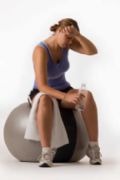If you’ve never tried a stationary bike, you’re missing out on a fantastic cardio exercise that strengthens your legs and lungs at the same time. A stationary bike is a low-impact option that's easy on your joints.
Types of Bikes
Not all stationary bikes are alike. There are two main types, an upright bike and a recumbent bike:
-
The first option, an upright bike, is like a regular bicycle (your legs extend below your torso and your back is not supported), only stationary.
-
Recumbent bikes offer a more relaxed, supported sitting position. Like a chair, they have seat backs to support your back, and instead of pedaling below, your legs usually extend in front of you.
The Set-Up
Proper bike set-up will give you an effective workout and reduce your risk of injury. Adjusting a bike to fit you usually involves three to four variables:
-
Seat height: On an upright bike, start by adjusting your seat to about the height of your hip. Have a seat, placing your feet on/into the pedals. With one leg fully extended (foot flat and parallel to the floor), you should have only a small bend in your knee—about 5-10 degrees. You should be able to pedal comfortably without having to point or flex your feet to reach full extension. Adjust your seat again if necessary to reach this position. On a recumbent bike, your legs should almost extend fully, keeping a small bend in the knee. Recumbent bike seats adjust forward and backward along a track.
-
Seat fore & aft (for upright bikes): Once you have adjusted your seat to proper height, some bikes allow you to move the seat forward and backward for a more comfortable position. When pedaling, your knees should be closely aligned with your ankles. If your knees are coming forward close to your toes or beyond, adjust the seat backward.
-
Handlebar height (for upright bikes): Adjust the handlebars so that you are in a comfortable position. Raising the handlebars higher will alleviate lower back stress that occurs when you learn forward. You should be able to reach the handlebars easily, keeping your elbows slightly bent.
-
Foot straps: Most bikes have straps that you can place your feet into when pedaling. Take advantage of this feature, which allows you to both push and pull the pedals, creating a much more efficient pedal stroke. The straps should fit snugly but not too tightly.
The Workout
Once you're set-up, you can manually control your workout incline, resistance, and speed, or you can try one of several programs that bikes offer. Adding resistance simulates hills and inclines, and engages your hamstrings and glutes more than riding with light resistance. Pedal with very little ankle movement, and remember to both push and pull up on the pedals for a better ride. For more workout ideas, check out these SparkPeople workout programs:
Stationary Biking for Speed
Stationary Biking for Endurance
Stationary Biking Intervals
Other Resources:
What to Expect From a Spinning Class
|







.png)
